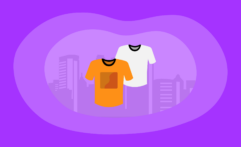How Sustainable Is Reclaimed Wood? Here Are the Facts
Impactful Ninja is reader-supported. When you buy through links on our site, we may earn an affiliate commission.
Learn more
Learn more
.
Hey fellow impactful ninja ? You may have noticed that Impactful Ninja is all about providing helpful information to make a positive impact on the world and society. And that we love to link back to where we found all the information for each of our posts. Most of these links are informational-based for you to check out their primary sources with one click. But some of these links are so-called "affiliate links" to products that we recommend. First and foremost, because we believe that they add value to you. For example, when we wrote a post about the environmental impact of long showers, we came across an EPA recommendation to use WaterSense showerheads. So we linked to where you can find them. Or, for many of our posts, we also link to our favorite books on that topic so that you can get a much more holistic overview than one single blog post could provide. And when there is an affiliate program for these products, we sign up for it. For example, as Amazon Associates, we earn from qualifying purchases. First, and most importantly, we still only recommend products that we believe add value for you. When you buy something through one of our affiliate links, we may earn a small commission - but at no additional costs to you. And when you buy something through a link that is not an affiliate link, we won’t receive any commission but we’ll still be happy to have helped you. When we find products that we believe add value to you and the seller has an affiliate program, we sign up for it. When you buy something through one of our affiliate links, we may earn a small commission (at no extra costs to you). And at this point in time, all money is reinvested in sharing the most helpful content with you. This includes all operating costs for running this site and the content creation itself. You may have noticed by the way Impactful Ninja is operated that money is not the driving factor behind it. It is a passion project of mine and I love to share helpful information with you to make a positive impact on the world and society. However, it's a project in that I invest a lot of time and also quite some money. Eventually, my dream is to one day turn this passion project into my full-time job and provide even more helpful information. But that's still a long time to go. Stay impactful,Affiliate Disclosure
Why do we add these product links?
What do these affiliate links mean for you?
What do these affiliate links mean for us?
What does this mean for me personally?
![]()
Reclaimed wood is wood that has been saved and repurposed. Using reclaimed wood has many environmental benefits, including reducing wood waste, lessening the pressure to cut down living trees, and shortening material transportation distances. Still, we had to ask: How sustainable is it to buy products made of reclaimed wood?
Reclaimed wood is one of the most sustainable materials and is generally more sustainable than virgin wood. It extends the lifespan and carbon sequestration of already used wood, reduces the need to cut down forests, and has relatively short transportation distances and low manufacturing emissions.
In this article, we’ll walk you through the life-cycle of reclaimed wood used in furniture, flooring, and house-building projects. Then, we evaluate its sustainability, potential, and shortfalls. And in the end, we’ll show you tips for buying sustainable reclaimed wood.
Here’s How We Assessed the Sustainability of Reclaimed Wood
Reclaimed wood is mostly sustainable because supposed wood waste has an extended life while keeping its role as carbon storage. Also, reclaimed wood has a lower CO2 and energy profile compared to virgin wood.
“Sustainable: The ability to be maintained at a certain rate or level | Avoidance of the depletion of natural resources in order to maintain an ecological balance”
Oxford Dictionary
To understand the sustainability of reclaimed wood, we assess the life-cycle of panels made with these types of material. This life-cycle assessment (LCA) is a method to evaluate the environmental impacts of each stage in a product’s life cycle, from the making to the recycling. Over the years, companies have strategically used LCA to research and create more sustainable products.
In this article, we’ll use the cradle-to-grave perspective of the LCA, examining the five stages of the life-cycle of reclaimed. We also use cradle-to-gate data where relevant.
| The life-cycle stages of reclaimed wood | Each stage’s sustainability |
| Sourcing of reclaimed wood | Sourcing reclaimed wood is generally sustainable because the process diverts wood waste into new functioning space instead of, e.g., a landfill. Reclaiming wood reduces deforestation as it demands relatively fewer resources than growing and cutting down living trees for timber. |
| Transporting of reclaimed wood | Transporting reclaimed wood can be relatively more sustainable than transporting new wood because reclaimed wood tends to be sourced and manufactured in more local, residential areas. In contrast, new wood often comes from far-flung forests. However, the environmental burden of transporting reclaimed wood also depends on hauling vehicles. |
| Manufacturing of reclaimed wood | Manufacturing reclaimed wood can have varying carbon footprints depending on the source and the state of the wood. However, the energy requirement and carbon emission of reclaimed lumber are likely to be lower, in some cases, than that of new wood because there might be no need for kiln drying. |
| Usage of reclaimed wood | Using reclaimed wood can be sustainable thanks to the carbon storage in the products. |
| End-of-life of reclaimed wood | The end-of-life stage for reclaimed is sustainable when the reclaimed wood is reused (again) or burned as bioenergy. |
We’ll say that reclaimed wood is one of the most sustainable materials and is generally more sustainable than virgin wood. However, the actual environmental impact of a particular product depends on many factors. These include the kind of wood that is reclaimed, the transportation distances, and the type of hauling vehicles. Let’s dive deeper into each stage and find out how it can be more sustainable.
How Sustainable Is the Sourcing of Reclaimed Wood
Sourcing reclaimed wood is generally sustainable because the process diverts wood waste into new functioning space instead of, e.g., a landfill. Reclaiming wood reduces deforestation as it demands relatively fewer resources than growing and cutting down living trees for timber.
What Type of Wood is Reclaimed and What Does This Mean for Sustainability
The reclaiming process works for all wood types, from softwood lumber supporting old barns to hardwood floors of trade houses no longer in use.
The most valuable reclaimed woods, sustainability-wise, are old-growth woods. These were harvested from trees left to grow to maturity and more. The longer trees grow, the more tightly packed their growth rings, which resist rot better.
Old-growth wood is more durable and less likely to splinter, split or warp than new-growth wood. Because of their physical advantages, sourcing old-growth wood, for example, from used buildings, could be more resource efficient than logging virgin timber from young trees.
Furthermore, the rapidly-diminishing old-growth, ancient forests, especially tropical rainforests, are critical to the world’s ecosystems and human health. Logging is strictly limited or forbidden in many of these forests.
Suppose you really want an ipe deck or a rosewood guitar because of these tropical woods’ excellent properties. It is then much better to source reclaimed old-growth ipe or rosewood than to risk encouraging illegal logging of these endangered species.
Similarly, reclaimed hardwoods are usually more sustainable than reclaimed softwoods because the hardwood trees tend to grow more slowly and provide denser, stronger, and longer-lasting timber. For example, a life-cycle assessment evaluating new and recovered softwood lumber and hardwood floors found that reclaiming hardwood floors reduces more CO2 emissions than reclaiming softwood lumber.
Where Is Reclaimed Wood Usually Sourced From
Reclaimed wood can be sourced anywhere, whether it’s a residential home or the bottom of a lake. In general, there are five main places where the wood can be reclaimed:
- Used structures
- Sawmill and factories
- Aging orchards
- Forest floors
- Water bodies
Reclaiming Wood From Used Structures
Taking wood from old structures that are no longer needed is referred to as post-consumer reclaim. Here are some examples:
- Bridges
- Boats
- Barns
- Decks
- Fences
- Storage sheds
Reclaiming Wood From Sawmills and Factories
In sawmills and factories, there are often wood scraps from making products like a table or a bed. Reclaiming these small pieces, the so-called post-industrial (reclaiming) content, clears spaces for manufacturing and avoids crowding up landfills with usable virgin woods.
Reclaiming Wood From Aging Orchards
Aging orchards, or everything from olive groves to mango plantations that are no longer productive at bearing fruits, are an ideal source for reclaimed woods. Cutting down old trees is needed to clear the space for generating new fruit crops. Instead of these trees ending up in landfills, the wood can be reclaimed for new woodworking projects.
Reclaiming Wood From Forest Floors
When timber trees are logged, especially with clear-cutting, many small-diameter trees are cut down and left behind on the forest floors. The wood from these trees can be turned into mulch, but they can also be reclaimed for suitable projects, such as small household items.
Reclaiming Wood From Water Bodies
Wood can be reclaimed from water bodies from natural lakes to man-made reservoirs. Sometimes, big bodies of water are created by building dams around (ancient) forests for water storage and/or energy generation. In this process, many trees have been submerged. Wood from these trees can be recovered and used in new projects.
Reclaiming wood from various sources helps to clean up nature, homes, and landfills, but the environmental benefits of reclaimed wood don’t stop there. It also affects carbon storage, which we’ll discuss in the following section.
What Does Using Reclaimed Wood Mean for Its Carbon Sequestration
Reclaiming wood to use in a new project is one of a few scenarios of what would happen to wood waste (such as the lumber structure of a no-longer-needed old barn). These scenarios mean differently to the carbon sequestered and stored in the wood by the living timber tree before it was cut down.
Let’s look at the various sceneries:
- Wood is reclaimed to build a new house
- Wood is disposed of in a landfill
- Wood is ground for mulch
- Wood is burned for energy
Scenario 1: When wood is reclaimed
If the wood is reclaimed, it is taken out of the old structure, transported to a storage unit, manufactured to be suitable for reuse, and then put into the new project. Throughout this process, the reclaimed wood keeps its carbon storage role.
Scenario 2: When wood is disposed of in a landfill
Alternatively, the supposed wood waste ends up in landfills, where it often decomposes faster than indoors due to fungi and insects.
When wood breaks down, carbon dioxide is not the only greenhouse gasses released back into the atmosphere. Methane is also present during decomposition.
Methane is 25 times more potent than carbon dioxide as a greenhouse gas. (Some landfills for construction waste have methane capture, but many don’t.) Thus, the release of methane has a much more immediate global warming effect.
Scenario 3: When wood is turned into mulch
When wood is ground into mulch, the mulch will continue to store carbon but not for as long as reclaimed wood panels because of the smaller size of the former. Wood mulch tends to decompose faster than solid wood.
Scenario 4: When wood is burned for energy
In some cases, wood waste is burned for energy. Then it is no longer carbon storage. However, burning wood (biomass) can replace burning fossil fuels like coal or natural gas.
Even though burning wood, similar to when coal or gas is burned, leads to carbon emissions, many scientists and policymakers consider wood carbon neutral and better than coal and gas in energy production. The reason is its renewability: once a tree is cut down and burned (and the stored carbon dioxide is released), another tree will grow and take back the carbon dioxide.
In brief, sourcing reclaimed wood is generally sustainable because it benefits the environment in prolonged carbon storage and the utilization of material and space.
How Sustainable Is the Transportation of Reclaimed Wood
Transporting reclaimed wood can be relatively more sustainable than transporting new wood because reclaimed wood tends to be sourced and manufactured in more local, residential areas. In contrast, new wood often comes from far-flung forests. However, the environmental burden of transporting reclaimed wood also depends on hauling vehicles.
Transporting reclaimed wood involves moving wood from the reclaimed source (be it an old home or a furniture factory) to where the recycled material is stored and processed to fit further use and then to the customer.
While all the transportation for reclaimed wood could happen locally within residential urban areas, it is most often not the case for new wood. New wood must travel from a forest, which is sometimes located in a different country or continent.
Transporting reclaimed wood, therefore, tends to have a shorter traveling distance and a lower carbon emission than new wood. However, the actual carbon footprint of transporting reclaimed wood depends on the hauling vehicles (type and fuel).
Calculations made by the Norwegian Forest and Landscape Institute showed that smaller wood hauling trucks emitted more CO2 per transported cubic meters of timber: 1.25 times more than larger wood hauling trucks, 1.3 times more than sea vessels, and six times more than freight trains. Therefore, the sustainable transportation option would be rail or large trucks running on biofuel.
You can check with your suppliers how their reclaimed wood is transported and opt for the more sustainable option.
How Sustainable Is the Manufacturing of Reclaimed Wood
Manufacturing reclaimed wood can have varying carbon footprints depending on the source and the state of the wood. However, the energy requirement and carbon emission of reclaimed lumber are likely to be lower, in some cases, than that of new wood because there might be no need for kiln drying.
Manufacturing reclaimed wood involves some or all of these tasks:
- Remove wood from the old structure
- De-nail
- Remove molds
- Remove pests
- Mill
- Re-dry
- Plane
- Cut and size
Electricity-powered tools might be used for jobs like removing wood, de-nailing, or milling. However, energy requirements for manufacturing reclaimed wood tend to be lower than for producing new timber. A life-cycle assessment calculated a 15 times higher fossil and biomass energy used to make new softwood framing lumber than to reclaim one.
From cradle to gate, reclaimed wood has a lower impact on global warming than new wood. Such impact is minor compared to the scenario when wood waste is left to decompose in landfills without methane capture. A life-cycle assessment with hardwood floors resulted in the following carbon emissions for a reclaimed floor, a landfilled floor, and a new floor
(where biogenic CO2 from burning wood waste is not included):
- Reclaimed hardwood floor: 175 kg CO2-e/m3
- Landfilled hardwood floor: 1030 kg CO2-e/m3
- New hardwood floor: 240 kg CO2-e/m3
How Sustainable Is the Usage of Reclaimed Wood
Using reclaimed wood can be sustainable thanks to the carbon storage in the products.
Using wood for an application like flooring is more sustainable than, for example, petroleum-based carpeting because wood is a renewable material (and carbon is sequestered during the renewal of wood).
Reclaiming old-growth wood is even better for the environment because of this type of wood’s superior physical strength. Reusing old-growth wood means your furniture or home tends to last longer while locking carbon dioxide inside.
How Sustainable Is the End-of-Life of Reclaimed Wood
The end-of-life stage for reclaimed is sustainable when the reclaimed wood is reused (again) or burned as bioenergy.
There are a few scenarios for reclaimed wood, similar to new wood – at the end of its life:
- Reclaimed wood can end up in landfills and keep its role as carbon storage as long as it doesn’t decompose.
- Reclaimed wood can also be recycled and reused again, extending its role as carbon storage.
- Reclaimed wood can be burned for biomass energy displacing coal or natural gas in generating electricity.
How Can You Buy Reclaimed Wood More Sustainably
The key to sustainably buying any wood is to check on relevant environmental and original certifications. Reliable certifications for sustainable woods are:
An FSC certification ensures that the red oak wood comes from responsibly managed forests that provide environmental, social, and economic benefits.The FSC Recycled label verifies products made 100% post-consumer reclaimed wood.
PEFC’s approaches to sustainable forest management are in line with protecting the forests globally and locally and making the certificate work for everyone. Getting a PEFC certification is strict enough to ensure the sustainable management of a forest is socially just, ecologically sound, and economically viable but attainable not only by big but small forest owners.
This certificate recognizes, evaluates, and certifies good practices in recovering and reusing un-utilized wood and other cellulosic biomaterial resources.
Why Is It Important to Buy More Sustainable Wood
Buying sustainable wood also means helping to prevent illegal or unsustainable logging, which harms the forests’ biosystems and accelerates climate change.
Logging of forestry products from plantations accounts for 26% of forest loss. Cutting down trees for wood has a lesser impact on carbon storage than digging up the whole forest floor and turning it into farms or mines. However, if logging is not sustainably managed, it can badly damage wildlife.
When logging happens in tropical forests – the bio hotspots of our planet – the biodiversity loss can be much more damaging. Subtropical and tropical forests are packed with unique wildlife – endemic mammals, birds, and amphibians. The displacement of such wildlife during poorly managed logging would be a major contributor to global biodiversity loss.
Sustainable management of forests also means that trees are cut down for timber only when they are mature. These trees will then be able to regrow and eventually replace the loss of canopy, absorb carbon from the atmosphere and reduce the effect of climate change.

Final Thoughts
If this option is available, you should buy products made with reclaimed wood because reclaimed wood is generally more sustainable than new wood. Recycling wood helps to clean up nature, industrial and residential spaces while lightening the environmental burdens of wood consumption. And, to make it even more sustainable, opt for, when possible, old-growth reclaimed wood that travels the least distance, use it for as long as you can, and arrange for it to be recycled fully.
Stay impactful,

Sources
- Science Direct: Life-cycle assessment (LCA)
- MIT SMR: Strategic Sustainability Uses of Life-Cycle Analysis
- European Environment Agency: cradle-to-grave
- Science Direct: Cradle-to-Gate Assessment
- TERRAMAI: WHY RECLAIMED WOOD? DISCOVERING THE BEAUTY AND SUSTAINABILITY OF RECLAIMED WOOD
- RECLAIMED WOOD MILLWORK: Reclaimed Wood Promotes Sustainability
- SpringerLink: Old growth forests and large old trees as critical organisms connecting ecosystems and human health. A review
- Impactful Ninja: How Sustainable Is Ipe Wood? Here Are the Fact
- Impactful Ninja: How Sustainable Is Rosewood? Here Are the Fact
- IUCNREDLIST: THE IUCN RED LIST OF THREATENED SPECIES
- Research Gate: Life cycle primary energy and carbon analysis of recovering softwood
- KnowledgeBank: Understanding Labels on Recycled Content: Post-Industrial, Pre-Consumer, and Post-Consumer
- Impactful Ninja: How Sustainable Is Olive Wood? Here Are the Fact
- Impactful Ninja: How Sustainable Is Mango Wood? Here Are the Fact
- Oregon Forest Resources Institute: When is clearcutting the right choice?
- MOTHER EARTH NEWS: Jurrasic Bark: Underwater Logging in Lake Superior
- Woodworking Network: Submerged Tropical Hardwoods Could Soon Be Harvested in Panama
- NSW: Research on carbon release from decomposition of wood and paper products
- Swedish University of Agricultural Sciences: Decomposition of wood
- SFGATE: How to Speed Up the Decomposition of Chipped Bark & Wood From Old Trees
- Impactful Ninja: What Is the Carbon Footprint of Biomass Energy? A Life-Cycle Assessment
- Science: Is wood a green source of energy? Scientists are divided
- Science Norway: Larger logging trucks give less CO2 emissions
- Treehugger: Is Reclaimed Wood Sustainable?
- Boston Building Resources: Old-Growth Wood: What It Is and Why It’s Worth Keeping
- Forest Stewardship Council
- Program for Endorsement of Forest Certification
- SCS Salvaged Wood & Fiber Standard
- Our World in Data: Deforestation and Forest Loss
- Our World in Data: Epidemic Mammal Species




